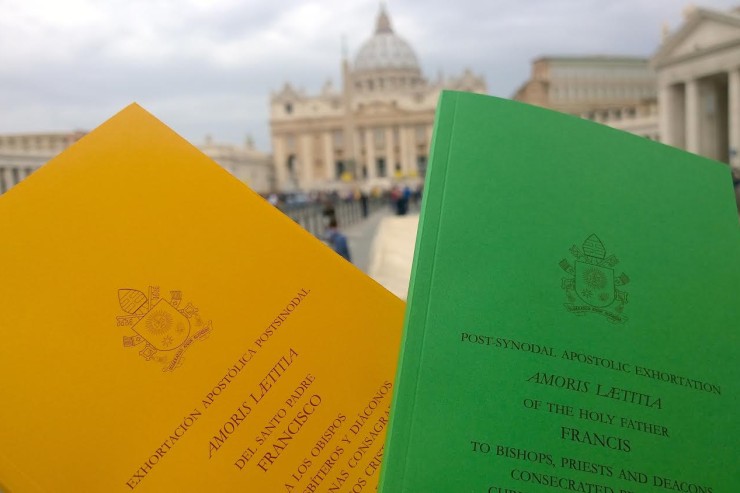“The Eighth Chapter of the Post-Synodal Apostolic Exhortation Amoris Laetitia” is the title of the book of Italian Cardinal and Canonist, Francesco Coccopalmerio, President of the Pontifical Council for the Interpretation of Legal Texts, which was presented at Vatican Radio in Rome this Tuesday, February 14, 2017, by Monsignor Maurizio Gronchi — Professor of Christology at the Pontifical Urban University and Consultor of the Congregation for the Doctrine of the Faith –, by Italian journalist and Vatican expert Orazio La Rocca, and by Father Giuseppe Costa, Director of the Libreria Editrice Vaticana, editor of the work. It is an invitation to put Christ back “at the center.”
“To Accompany, Discern and Integrate Frailty”
The eighth chapter of Amoris Laetita, entitled “To Accompany, Discern and Integrate Frailty,” dedicated to “irregular unions,” is the one that has sparked most interest and questions on a Post-Synodal Apostolic Exhortation: there Pope Francis invites to more attentive pastoral care for individual persons, characterized by accompaniment, discernment and integration of the frailty” without harming, however, the traditional doctrine of the Church on the Sacrament of Marriage, validly celebrated.
Italian journalist Orazio La Rocca says he is convinced by the canonist’s book: “The doubts raised aroused some questions in me, among them, the idea that the doctrine was wounded. In fact, no: with this text, the Cardinal (Coccopalmerio explains in a didactic and very penetrating way that the doctrine is not touched and that, at the same time, the wounded persons are daughters of the Church that opens herself as a mother.”
The Question of Conversion
For his part, Monsignor Gronchi showed on Vatican Radio how Cardinal Coccopalmiero helps to understand what the Pope wrote in Amoris Laetitia and that serious conditions exist for the eventual access to the Sacraments of baptized persons married in the Church and then divorced and remarried: “The “additional” things the Cardinal says are found on page 27 and page 29 of the book. They are, in fact, that: “the Church could admit to Penance and to the Eucharist faithful who find themselves in a non-legitimate union, but who fulfill two essential conditions: they desire to change the situation but they cannot realize their desire.” And on page 29: “…this intention is exactly the theological element that allows for absolution and access to the Eucharist, always, we repeat, in the presence of the impossibility of changing immediately the situation of sin.” These are the expressions with which the Cardinal takes a step of interpretation in the line of the Exhortation.”
He specifies: “Here, to change is understood as the desire for conversion. He does not specify if this means returning to the previous situation, committing perhaps a new fault, the Cardinal said that; he does not specify if that means seeking to abstain from conjugal relations, as indicated in number 84 of Familiaris Consortio. It is a question of conversion. And, consequently, the intention to be more conformed to Christ renders it legitimate, because it is the intention, access to the sanctifying grace of the Sacraments. This does not contradict the doctrine of repentance, or the doctrine of sanctifying grace. These are the expressions of the Cardinal.
Field Hospital and Safety of Doctrine
For him, “to accompany, discern and integrate the frailty” could constitute a cultural model for society “… and also for politics. What does it mean for a civil, social, political community to take charge of situations of greatest frailty? I am thinking of immigrants, the poor, handicapped people, persons socially excluded … it is the duty of every society, of politics, of the Church. Let us think of what that means for the economy, for international relations, etc. “
He also affirms that the Church is a “field hospital” but that this is not an alternative to the safety of the traditional doctrine … “because the Church has always been the refuge of sinners”: ‘I have not come to judge but to give life.’ It is necessary to understand if Jesus is considered absolutely as the center, and if His Death and His Resurrection are the center of the doctrine around which the doctrinal aspects are organized according to a hierarchy of truths, or if we put at the center any aspect that is, on the contrary, on the periphery. The Pope very often puts in evidence the importance of the peripheries when it is a question of situations of marginalization. Consequently, he invites to discernment. However, it is interesting that sometimes this discourse goes also in the inverse sense: there are certain doctrinal peripheries that are put at the center forgetting that Jesus is the center.”

Amoris Laetita --ZENIT HSM
Cardinal Coccopalmerio, Canonist, Dedicates a Book to Chapter 8 of “Amoris Laetitia"
Or How “To Accompany, Discern and Integrate Frailty”


